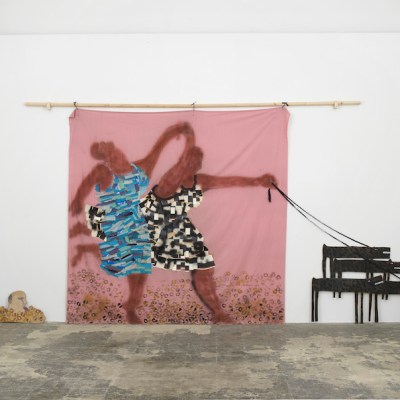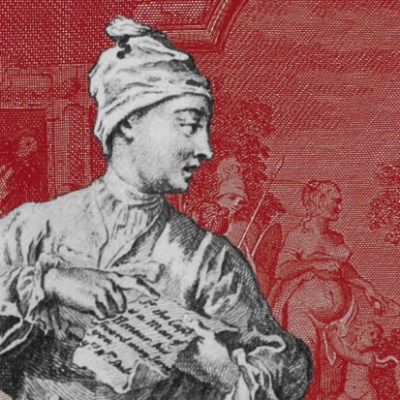This year’s Turner Prize exhibition, which is taking place in Hull’s Ferens Art Gallery, is a quieter affair than the showcase at Tate Britain in 2016. There are no headline-grabbing images to match Anthea Hamilton’s giant buttocks or Michael Dean’s sea of coins from last year. Instead, ideas about rootlessness and belonging, states of limbo and states of grace, pervade the array of paintings, prints, sculptures, films and installations by the four shortlisted artists: Hurvin Anderson, Andrea Büttner, Lubaina Himid and Rosalind Nashashibi.
Lubaina Himid’s exhibition functions as a kind of mini-retrospective for the 63-year-old artist, who along with Hurvin Anderson qualifies for the 2017 prize following a decision to scrap the upper age limit of 50 years. A succession of mostly unnamed black figures – individuals lost to history – populates her work. In one piece they are painted onto a traditional dinner service, to commemorate the abolition of the slave trade; in another, a black woman features in a theatrical arrangement of rough cut-outs that restage a scene from Hogarth’s Marriage à-la-mode (1743) for the Thatcher age. Mirroring this large-scale installation (which dates from 1987) is a more recent painting, Le Rodeur: Exchange (2016), depicting five people in an elegant tableau. The work’s source – a horrific episode in the history of the slave trade, in which an infection caused the passengers of a slave ship to suddenly go blind – is obliquely referenced with a view of the ocean and a tiny eye standing in for a button on a coat. Strangely dreamlike, not least because one of the characters has a bird’s head, the painting is charged with a sense of magical suspension. Himid’s noble figures appear on the one hand trapped by history, and yet poised on the brink of flight.
Le Rodeur: The Exchange (2016), Lubaina Himid. Loaned from Hollybush Gardens

Like Himid, German artist Andrea Büttner reconsiders and elevates forgotten people in her work. In her display, images of beggars from art history are exhibited on a low table, quite literally begging a closer look, while a series of nine woodblock prints, based on Ernst Barlach’s 1919 sculpture of a cloaked mendicant, initially seem childlike in terms of their composition, but prove deeply affecting. Elsewhere, overlooked forms of labour are alluded to via simple statements of colour: a wall covered in yellow Hi-Vis fabric underscores the efforts of emergency service workers; a piece of blue fabric laid across a table turns out to be a fine silk made by nuns. Musings from Simone Weil’s L’Enracinement (The Need for Roots), which was published posthumously in 1949, also feature. They have been loaned from the Peace Library and Antiwar Museum of the Evangelical Church in Berlin as a complete display, pinned to easily transportable frames – the kind you see in schools or libraries. There’s a charming didacticism to Büttner’s showcase overall.
Beggar series (2016), Andrea Büttner. Loaned from Hollybush Gardens

Weil’s thoughts on displacement link, indirectly, to Hurvin Anderson’s beguiling paintings. These are the highlight of the prize, some of which deal literally and metaphorically with roots. His lush landscapes, often painted on large-scale grids, fuse different memories and sources, notably the trees of the UK and Jamaica, where the artist’s parents were born. Two large-scale paintings depict a figure almost completely obscured by foliage, which gives the impression of something glimpsed in a dream or recreated from a lost source. In a video on display in another room, Anderson talks about people ‘forgetting’ where they are from, and there’s something liberating about the possibility of misremembering or remixing one’s past and place in the world. Paintings alluding to race – Is it OK to be Black? (2016), for example, from a series of works set in barbershops – are undoubtedly political yet at the same time evoke spaces of introspection.
Across the Tracks (2013) and Northern Range (2010), Hurvin Anderson. Loaned from the Halamish Collection / Loaned from a private collection, courtesy Michael Werner Gallery

There’s a hermetic feel to the two films by Rosalind Nashashibi, one shot in the Gaza Strip in 2014 and another more recently in the Guatemalan home of mother and daughter artists, Elisabeth Wild and Vivian Suter. Electrical Gaza (2015) combines claustrophobic footage of narrow alleyways and the Rafah Crossing with moments of animation which seem to breathe air into the scenes. The threat of violence, however, is ever-present and finally communicated via an ominous black circle overlaid onto a street scene. Vivian’s Garden (2017 follows mother and daughter as they go about their apparently cloistered lives. Comparisons to the 1975 documentary Grey Gardens are inevitable, especially in the couple’s oddly infantile relations. But here, too, there are moments of unexpected transcendence and pathos, whether in the protagonists’ tender exchanges, or in the footage of a painting bobbing through the trees as it’s carried through a forest.
Electrical Gaza (2015), Rosalind Nashashibi. Photography by Emma Dalesman, animation by Visitor Studio, produced by Kate Parker. Loaned from Rosalind Nashashibi

So, another year, another Turner Prize. Unshowy, yet no less impressive, 2017’s exhibition feels perfectly judged to suit our tangled current climate.
The Turner Prize 2017 exhibition is at the Ferens Art Gallery, Hull, until 7 January 2018.



